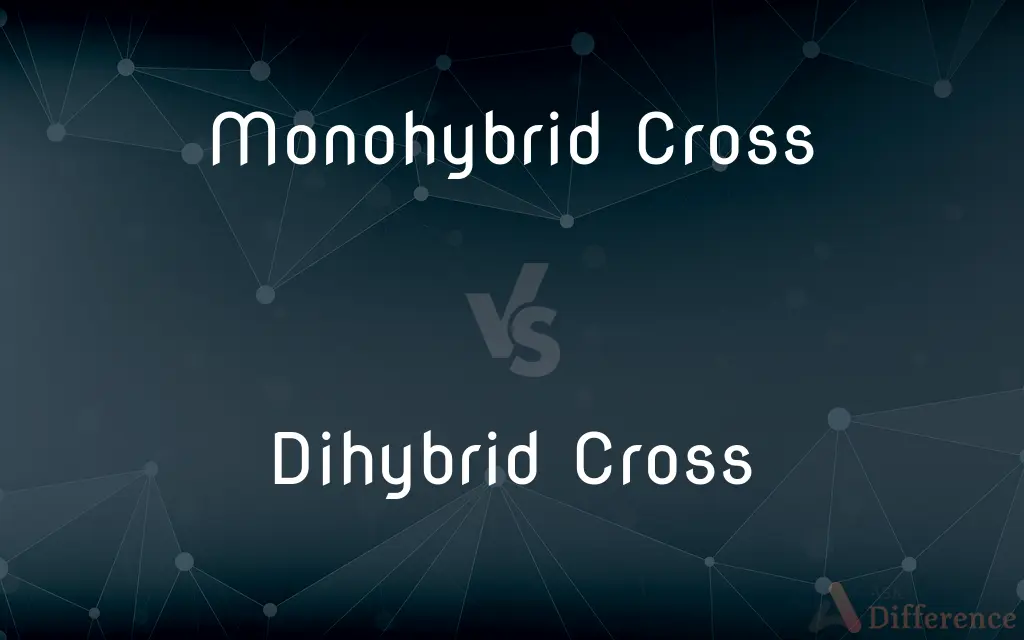Monohybrid Cross vs. Dihybrid Cross — What's the Difference?
Edited by Tayyaba Rehman — By Fiza Rafique — Published on December 8, 2023
Monohybrid Cross studies inheritance of a single trait, while Dihybrid Cross examines two traits simultaneously.

Difference Between Monohybrid Cross and Dihybrid Cross
Table of Contents
ADVERTISEMENT
Key Differences
Monohybrid Cross and Dihybrid Cross are fundamental concepts in genetics, designed to study the inheritance patterns of traits. A Monohybrid Cross refers to the study of the inheritance of one particular trait by crossing two pure-breeding organisms, each with a different version of the trait. For example, crossing purebred tall pea plants with purebred short ones. Conversely, a Dihybrid Cross investigates the inheritance patterns of two distinct traits by mating two individuals that are heterozygous for both traits.
Understanding genetic inheritance necessitates comprehension of both Monohybrid and Dihybrid Crosses. A Monohybrid Cross reveals the inheritance pattern of a singular trait, focusing on one pair of alleles. For instance, it can elucidate the dominance relationship between two alleles of a gene. On the other hand, Dihybrid Cross delves into two pairs of alleles, illustrating how they segregate and assort independently during gamete formation, thus affirming Mendel’s Law of Independent Assortment.
In the realm of practical application, both Monohybrid and Dihybrid Crosses offer insights into breeding and genetic counseling. Through a Monohybrid Cross, breeders can predict the probability of offspring exhibiting a particular trait, useful in breeding animals or plants for desired attributes. Dihybrid Cross, with its broader scope, offers a more comprehensive view, allowing the prediction of offspring combinations for two traits simultaneously, expanding the genetic prediction's depth and range.
Gregor Mendel, the father of genetics, utilized both types of crosses in his experiments with pea plants. Using a Monohybrid Cross, he deduced the principles of dominance and recessiveness by observing one trait at a time. With Dihybrid Cross, Mendel explored two traits concurrently, leading him to propose the Law of Independent Assortment, which states that allele pairs separate independently during gamete formation.
Comparison Chart
Number of Traits Studied
One trait is studied.
Two traits are studied simultaneously.
ADVERTISEMENT
Genes Involved
Involves one pair of alleles.
Involves two pairs of alleles.
Purpose in Mendel's Experiments
Demonstrated principles of dominance and recessiveness.
Led to the proposal of the Law of Independent Assortment.
Genotypic Ratio (Typically)
1:2:1 (for a simple dominant-recessive trait).
9:3:3:1 (for two simple dominant-recessive traits).
Phenotypic Ratio (Typically)
3:1 (for a simple dominant-recessive trait).
9:3:3:1 (when both genes have two alleles showing simple dominance).
Compare with Definitions
Monohybrid Cross
A cross that helps understand dominance relationships between alleles.
A Monohybrid Cross helped Mendel understand that the tall trait in pea plants was dominant over the short trait.
Dihybrid Cross
A cross that explores combinations of phenotypes for two traits.
A Dihybrid Cross might reveal combinations like round-yellow, round-green, wrinkled-yellow, and wrinkled-green seeds.
Monohybrid Cross
A genetic cross examining the inheritance of one trait.
A Monohybrid Cross between two heterozygous tall pea plants can produce both tall and short offspring.
Dihybrid Cross
A genetic cross studying the inheritance of two traits simultaneously.
A Dihybrid Cross between two plants might consider both seed shape and color.
Monohybrid Cross
A cross between organisms with two different variations of a single trait.
Crossing red-flowered with white-flowered plants is a Monohybrid Cross if only flower color is considered.
Dihybrid Cross
A cross involving four alleles from two different genes.
A Dihybrid Cross could study the A and a alleles from one gene and the B and b alleles from another gene.
Monohybrid Cross
A cross focusing on a single pair of alleles.
A Monohybrid Cross might study the A and a alleles of a particular gene.
Dihybrid Cross
A cross between organisms heterozygous for two traits.
Crossing two plants that are RrYy results in a Dihybrid Cross focusing on seed shape and color.
Monohybrid Cross
A genetic tool to predict the phenotypes of offspring for one trait.
Using a Monohybrid Cross, scientists can predict the height distribution of pea plant offspring.
Dihybrid Cross
A genetic tool to understand the independent assortment of alleles.
Using a Dihybrid Cross, Mendel deduced that different traits are inherited independently.
Common Curiosities
How many traits are studied in a Monohybrid Cross?
A Monohybrid Cross studies a single trait.
What is the primary difference between Monohybrid and Dihybrid Crosses?
Monohybrid Cross examines one trait, while Dihybrid Cross examines two traits simultaneously.
What is the typical phenotypic ratio in a Dihybrid Cross?
The typical phenotypic ratio for a Dihybrid Cross is 9:3:3:1.
What did Mendel demonstrate using a Monohybrid Cross?
With a Monohybrid Cross, Mendel demonstrated principles of dominance and recessiveness.
What's the main goal of a Monohybrid Cross?
The main goal is to understand inheritance patterns of one specific trait.
Can Dihybrid Cross predict phenotype combinations?
Yes, it can predict phenotype combinations for two traits.
What law was proposed using a Dihybrid Cross?
A Dihybrid Cross led Mendel to propose the Law of Independent Assortment.
Do both crosses involve breeding organisms?
Yes, both involve breeding organisms with certain genetic makeups.
How many alleles are involved in a Monohybrid Cross?
Two alleles are involved.
Do both crosses involve alleles?
Yes, Monohybrid Cross involves one pair of alleles, while Dihybrid involves two pairs.
Can you use a Dihybrid Cross to study more than two traits?
Typically, a Dihybrid Cross studies two traits, but more complex crosses can study more traits.
Which cross helped understand the Law of Dominance?
The Monohybrid Cross helped understand the Law of Dominance.
Why do Dihybrid Crosses have a 9:3:3:1 ratio?
It's due to the independent assortment of two gene pairs during gamete formation.
What genotypic ratio arises from a simple Monohybrid Cross?
The typical genotypic ratio is 1:2:1.
How many phenotype possibilities arise in a Dihybrid Cross of two simple traits?
Four phenotype possibilities arise.
Share Your Discovery

Previous Comparison
Imax 3D vs. Imax
Next Comparison
GAAP vs. 704 BAuthor Spotlight
Written by
Fiza RafiqueFiza Rafique is a skilled content writer at AskDifference.com, where she meticulously refines and enhances written pieces. Drawing from her vast editorial expertise, Fiza ensures clarity, accuracy, and precision in every article. Passionate about language, she continually seeks to elevate the quality of content for readers worldwide.
Edited by
Tayyaba RehmanTayyaba Rehman is a distinguished writer, currently serving as a primary contributor to askdifference.com. As a researcher in semantics and etymology, Tayyaba's passion for the complexity of languages and their distinctions has found a perfect home on the platform. Tayyaba delves into the intricacies of language, distinguishing between commonly confused words and phrases, thereby providing clarity for readers worldwide.












































